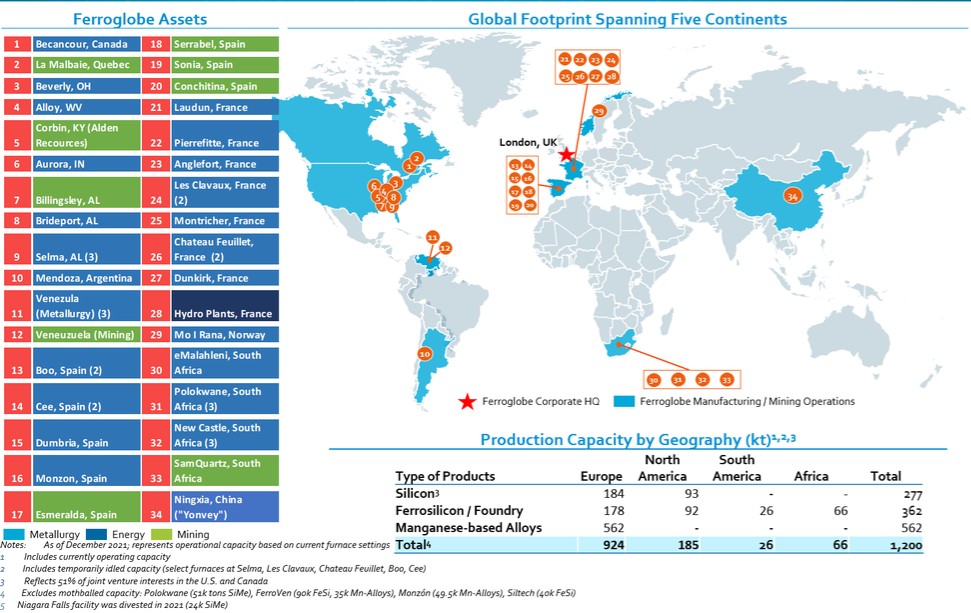at maturity for an additional period of 1 to 5 years. Interest rate is zero percent and the borrower shall be liable to pay a fee equal to 0.50% equal to an amount of €22 thousand calculated on the total borrowed capital.
On June 2, 2020, Ferroglobe subsidiary, Silicium Québec, as borrower, agreed a $7,000 thousand loan with Investissement Québec, a regional government loan & investment agency, as lender, to finance its capital expenditures activities in Canada. The loan is to be repaid in 84 installments over a 10-year period with the first three years as a grace period. Interest rate on outstanding amounts is zero percent.
Ferroglobe’s primary short-term liquidity needs are to fund its capital expenditure commitments, fund specific initiatives underlying the strategic plan, service its existing debt and working capital. Ferroglobe’s long-term liquidity needs primarily relate to debt repayment. Ferroglobe’s core objective with respect to capital management is to maintain a balanced and sustainable capital structure through the economic cycles of the industries in which it participates, while keeping the cost of capital at competitive levels.
For the year ended December 31, 2021, operating activities generated a cash flow of ($1,341) thousand, compared to $154,268 thousand in 2020 and ($31,194) thousand in 2019, mainly due to the increase in inventories and trade and other receivables. Investing activities resulted in a total outflow of $23,848 thousand of cash in 2021, compared to an outflow of ($31,940) thousand in 2020 and an inflow of $165,910 thousand in 2019. Financing activities resulted in a total inflow of $10,452 thousand in cash in 2021, compared to an outflow of $113,333 thousand in 2020 and an outflow of $224,005 thousand in 2019. See “Cash Flow Analysis” below for additional information.
As of December 31, 2021 and 2020, Ferroglobe had cash, restricted cash and cash equivalents of $116,663 (of which $2,272 thousand is restricted cash) and $131,557 (of which $28,843 thousand is restricted cash), respectively. Cash and cash equivalents are primarily held in U.S. Dollars and Euros.
As of December 31, 2021, Ferroglobe’s total gross financial debt was $618,552 thousand as compared to $551,547 thousand as of December 31, 2020. As of December 31, 2021, gross financial debt comprised debt instruments of $440,297 thousand ($357,508 in 2020), bank borrowings of $98,967 thousand ($107,606 in 2020), $18,358 thousand of leases ($22,536 thousand in 2020), and other financial liabilities of $60,930 thousand ($63,896 thousand in 2020).
We believe our working capital is sufficient for our present requirements, and we anticipate generating sufficient cash to satisfy our short and long-term liquidity needs.
Availability of funds
At December 31, 2021, we had cash and cash equivalents, restricted cash and other restricted funds amounted to $116,663 million. This amount includes non-current restricted cash in relation to the guarantees taken over escrow amounting $2,272 thousand. The escrow was constituted in August 30, 2019, in consideration of previous FerroAtlántica. The Company also has certain restrictions for the disposal of the cash in Norway due to local requirements and in the joint ventures with Dow Corning amounting as of December 31, 2021 amounting to $53,453 thousand.
Ferroglobe PLC is the parent company of Ferroglobe Group and receives funding from its subsidiaries in the form of intercompany loans. Consequently, certain restrictions on the ability of the Group’s subsidiaries to transfer funds to Ferroglobe PLC would negatively affect our liquidity and thus our business.
Working Capital Position
As of December 31, 2021, Ferroglobe’s working capital position (defined as inventories and trade and other receivables less trade and other payables) was $464,870 thousand as compared to $339,610 thousand as of December 31, 2020, mainly due to an increase in inventories by $60,296 thousand and receivables by $161,434 thousand partially offset for an increase in payables by $64,382 thousand.

